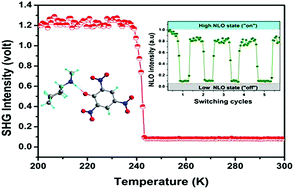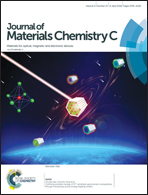Switchable behaviors of quadratic nonlinear optical properties originating from bi-step phase transitions in a molecule-based crystal†
Abstract
Solid-state nonlinear optical (NLO) switches are recently emerging as a new class of promising stimuli-responsive materials for photoelectric application. Herein, we report an organic molecular crystal, N- methylcyclohexylamine picrate (1), which exhibits remarkable switching behaviors of quadratic NLO properties with a large contrast of ∼20 between its NLO-on and NLO-off states. This is almost comparable with the conventional photochromic counterparts, and suggests the great potential of 1 as a quadratic NLO-switching candidate. It is noteworthy that 1 undergoes bi-step structural phase transitions at T1 = 240 K and T2 = 285 K, which are closely associated with its NLO-switching activities. Above T1, disordering of anionic and cationic moieties leads to vanishing of the NLO effect, (i.e. NLO-off state). In contrast, below T1, stepwise frozen ordering of the structural moieties generates strong NLO activities, with the NLO response being ∼0.9 times that of KH2PO4. Such an order–disorder transformation accounts for the high-contrast NLO switching of 1. It is believed that this finding affords an effective strategy for designing new stimuli-responsive materials.



 Please wait while we load your content...
Please wait while we load your content...